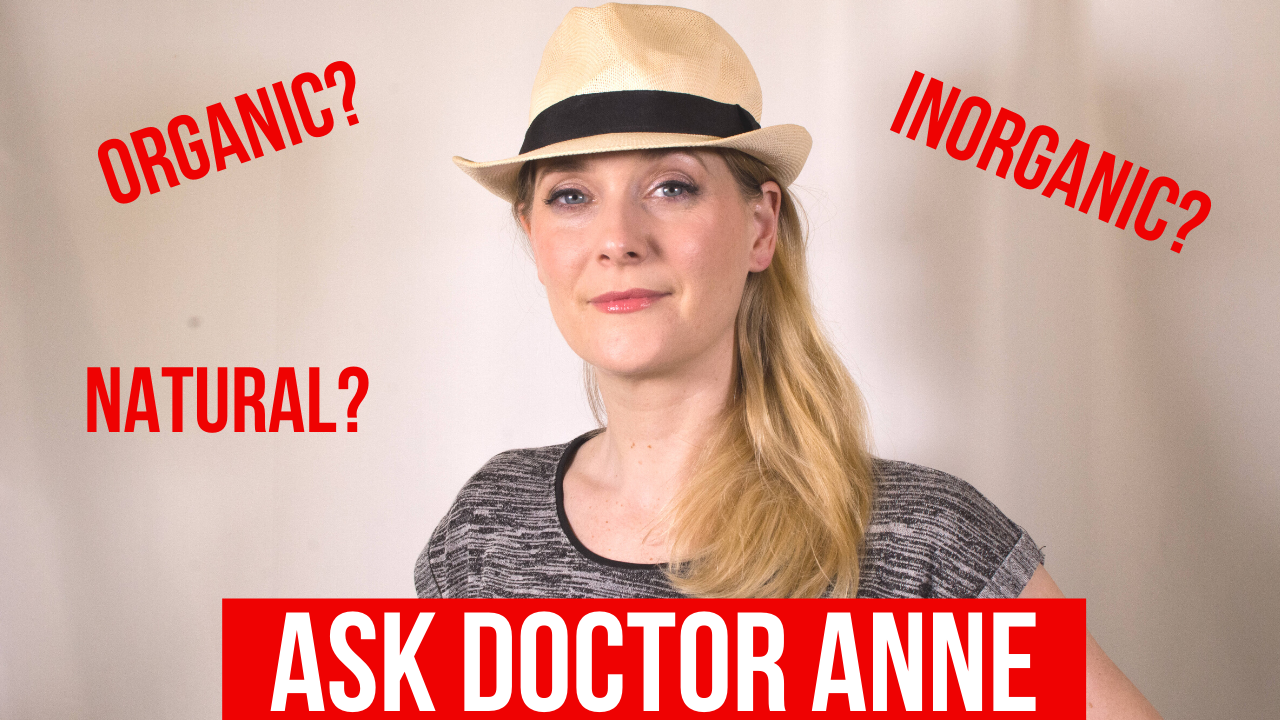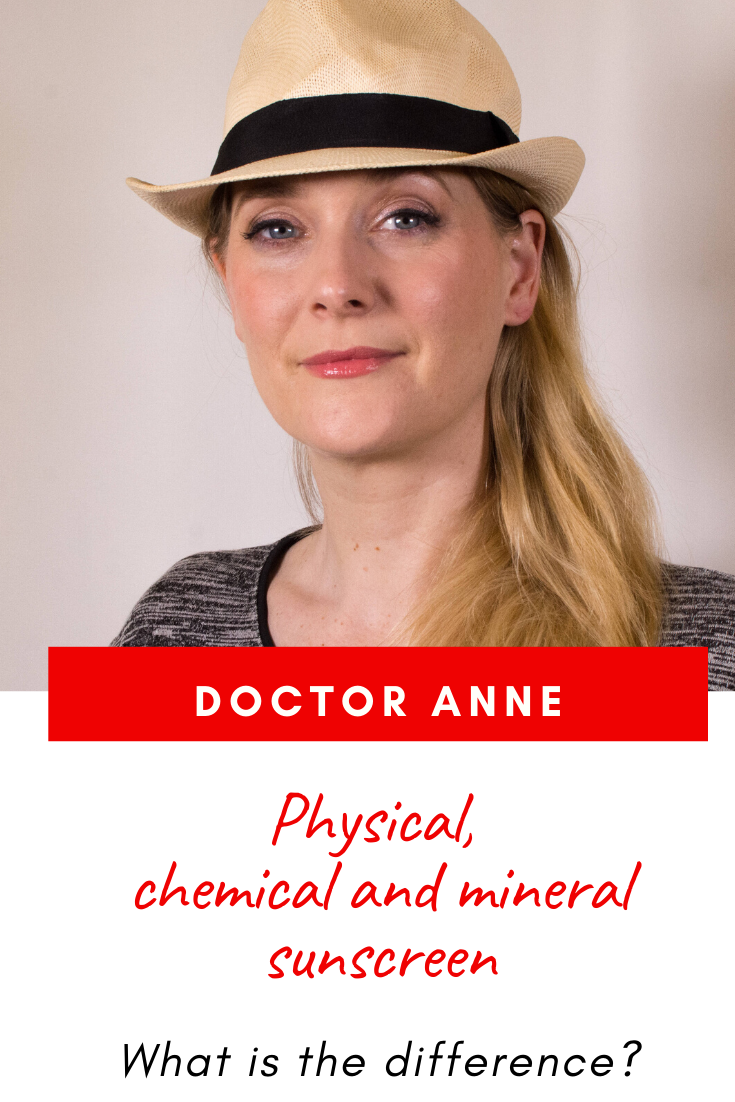You know I go on and on about the importance of wearing sunscreen all year round, but I get that when summer is here, that topic gets more and more attention. So I asked you guys if you had any questions you wanted me to answer. And yes, you had indeed!
So let´s get to the first one: What is the difference between mineral, chemical and physical sunscreen? And is one better than the other?

Sadly the different kinds of suncreen divide the online community up to a point where battles are fought about which kind is the right kind, so let me preface this video with this important statement:
I don´t care which sunscreen you wear as long as it is broad spectrum and you wear it every day!
1. The different names
Back when I was young (centuries ago), we only had two categories: Physical and chemical.
To be honest, when I was young as in a preschooler, we had one bottle of coconut scented stuff with an SPF of 4 that would allegedly enhance tanning. I wanted to say that stuff like this doesn´t exist anymore, but a quick google search proved me wrong – something similar is still available. Not linking to it though, hings like that don´t deserve any traffic!
Anyway, back to topic: At first there were physical and chemical filters.
Somewhere along the way some people mentioned correctly that everything is a chemical, so the filters should be called organic (chemical) and inorganic (physical) instead, and then of course marketing had to step up and rename the physical ones to mineral or natural sunscreen, because that apparently sells better.
To complete the confusion, these days some brands sell „natural sunscreen“ and refer to antioxidants, which are great, but of course no sunscreen!
Don´t despair though, it is actually pretty easy, so let´s go through it one by one.
2. Physical or inorganic sunscreens
Physical sunscreens are also called inorganic or mineral sunscreens, because their two filters are zinc oxide and titanium dioxide, based on minerals.
Some People refer to it as “natural ” sunscreen, but calling them natural is of course misleading, as they need to undergo a purification process before suitable for use in skincare products, so they are as processed as any other filter you will find.
The downsides of physical sunscreens are the fact that they tend to leave a white cast and are often less „cosmetically elegant“, meaning they are denser and harder to distribute.
An advantage is that they usually cause less irritation than some of the chemical filters out there, which is especially true if you rely on US sunscreens.
You might have heard that physical sunscreens reflect light rather than absorb it, which is what chemical sunscreens do, but that is not entirely true. Physical sunscreens reflect around 5% of the incoming UV rays and absorb the rest, so there is basically no difference in how they work on your skin.
It is important to note that only zinc oxide will provide enough protection from UVA rays to qualify as broad spectrum sunscreen, and that blue light, which has become kind of a hot topic (I talked about it here) is in parts absorbed by mineral sunscreens.
3. Chemical or organic sunscreens
There is a broad variety of substances that fall under this category, and not all of them are available in every part of the world, which is why I am not going to list all of them, but focus on the most important ones here.
The main part that sets them apart is the spectrum, in which they absorb the UV-rays. Most are effective either in the UVA or in the UVB range, with only a few absorbing both equally good (called broadspectrum underneath).
UVB protection:
– Homosalate (approved in the US)
– Octocrylene (approved in the US)
– Octinoxate (approved in the US)
– Octisalate (approved in the US)
– Oxybenzone (approved in the US)
– Tinosorb A2B (broadspectrum)
– Tinosorb S (broadspectrum)
– Tinosorb M (broadspectrum)
– Uvinul T 150
There are also a few others, but these are the ones you will most often find in current formulations
UVA protection:
Avobenzone is (with the exception of Mexoryl SX, a patented filter by L´Oréal) the only chemical filter for UVA protection that is available in US sunscreens. It is however rather unstable and often irritating and partly responsible for the bad rep chemical sunscreens get from those with sensitive skin.
Modern UVA filters I look out for are
– Tinosorb M (broadspectrum)
– Tinosorb S (broadspectrum)
– Tinosorb A2B (broadspectrum)
The downside of chemical or organic filters is that especially the older ones can be irritating and are unstable when used alone, their advantage is that they are usually much easier to spread and more comfortable to wear without that thick sunscreen feeling.
A quick word on them being hormonal disruptors and being absorbed into the body – there is no data showing that the amount absorbed is of any concern for human beings, as the amount you would need to have a hormonal effect is euqivalent to continuus use for several hundred years.
Oh, and for the coral reef debate – I will link to a post Lab Muffin Beauty made on this Topic and just say: I agree!
4. Antioxidants sold as “natural sunscreen”
UV radiation is one of the main sources of free radicals, which in turn lead to oxidative damage to the cells and skin aging. Antioxidants help catch the free radicals, preventing this damage. On top of that sunscreen filters themselves can produce free radicals when they degrade. This risk is higher, the more unstable the filter is, read higher with old chemical filters.
Knowing that it makes perfect sense to add antioxidants to sunscreen in order to enhance ist positive effects.
It does however NOT make any sense at all to use antioxidants instead of sunscreen, claiming that they will undo the damage done by the UV rays, which is why you don´t need any filters. It doesn´t work that way. Antioxidants can only prevent a little, and UV exposure leads to a burst of free radicals appearing – there is just not enough Vitamin C in your products and your diet to counteract that.
Wear a proper, broad spectrum sunscreen and if that contains antioxidants, even better. If not, consider using an antioxidant serum in your skincare routine, especially given the fact that antioxidants might as well protect against the damage done by blue light.
But never, ever use antioxidants INSTEAD of sunscreen.
And never ever use sunscreen drops to mix into your day cream, but that is a topic for a different blogpost. Any questions I did not answer?



